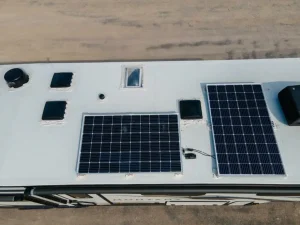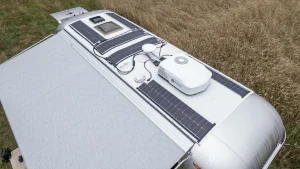Whether you’re solar-curious or waiting for “the right year,” 2025 gives you a clear reason to act: power rates remain elevated, quoting is more transparent, and the policy window still rewards projects completed this year. This guide doesn’t hand-wave about savings—it grounds the solar power cost conversation in real, per-watt numbers tied to actual installation tasks and interconnection steps. We’ll open with fresh marketplace benchmarks, break down hardware vs. soft costs and the variables that move quotes, show how batteries change the math and payback, and share ten field-tested ways to lower your solar panel installation cost. We’ll close with three copy-and-paste Sungold system recipes so you can turn these ideas into a bill of materials and a 2025-ready project timeline.
2025 solar panels cost: what homeowners actually pay
Marketplace snapshot (national): EnergySage’s latest update (Sept 9, 2025) shows the average cost-per-watt at ~$2.53/W (pre-incentive). Their 12-kW example prices are $29,649 before and $20,754 after the federal credit, and they explicitly flag that the 30% credit ends for new residential expenditures after Dec 31, 2025.
Research benchmark (multi-year medians): LBNL’s Tracking the Sun 2024 (data through 2023) reports state median residential prices typically ~$3.2–$5.2/W—higher than competitive marketplace quotes because of method and sample differences. Use marketplace $/W to judge quotes; use LBNL to understand long-run structure and variance.
Illustrative budgets (grid-tied, no battery):
| System size | Pre-credit $/W (reference) | Pre-credit total | 30% credit (if placed in service 2025) | Net after credit |
|---|---|---|---|---|
| 7 kW | ~$2.5–$2.9 | ~$17,500–$20,300 | −$5,250 to −$6,090 | ~$12,250–$14,210 |
| 10 kW | ~$2.4–$2.8 | ~$24,000–$28,000 | −$7,200 to −$8,400 | ~$16,800–$19,600 |
| 12 kW | ~$2.4–$2.7 | ~$28,800–$32,400 | −$8,640 to −$9,720 | ~$20,160–$22,680 |
Why your solar panel installation cost looks the way it does
For a representative 12-kW system at $29,649 (pre-credit), EnergySage’s 2025 breakdown puts: Solar panels ~12%, inverters ~10%, racking ~3%, wiring ~9%, and the rest across sales/marketing (~18%), overhead (~11%), permitting & interconnection (~8%), labor (~7%), profit (~11%), supply chain and tax. Translation: your solar pv panels cost is only a slice of the full solar power cost you see on a quote.
Five variables that move your quote up or down
Roof complexity: Pitch, stories, material, shading, and conduit/line runs strongly influence install hours and BOS.
Electrical scope: Main panel upgrades, rapid-shutdown wiring, and your choice of microinverters vs. string + optimizers.
Local policy: Permitting fees, inspection cadence, net metering (NEM) rules, and utility interconnection timelines.
System size & spec: Larger systems often carry lower $ per watt, but higher total dollars; premium module/inverter choices add margin.
Competition: Compare at least 3–4 quotes from a vetted solar energy company network using identical specs (kW, inverter type, warranties). Competitive quoting is one of the fastest ways to trim solar panel installation cost.
Adding storage: the cost of solar panels + batteries in 2025
Typical budget point: A 13–14 kWh home battery system often lands ~$9,400 after the federal credit (when installed and placed in service in 2025). Marketplace medians benchmark ~$1,037/kWh installed.
Brand anchor for context: Multiple industry trackers peg Tesla Powerwall 3 around ~$15,400 installed before incentives (quotes vary by locale, BOS scope, and bundling).
When batteries make the most sense: frequent outages (critical loads), aggressive time-of-use rates, weak NEM/export values, or resilience requirements that aren’t captured by bill savings alone.
Note the deadline: the 30% residential credit on batteries also ends for expenditures after 12/31/2025; installations must be completed in 2025 to qualify.
Ten proven ways to lower your solar power cost
Compare 3–4 like-for-like quotes (same kW, inverter type, warranties) to create price pressure.
Right-size the system to your kWh usage and NEM rules—avoid oversizing if export values are weak.
Optimize orientation & stringing: prioritize south/south-west planes; use module-level power electronics only where shading requires it.
Simplify the layout: continuous arrays with shorter home runs cut BOS and labor.
Choose “upper-mid” hardware instead of ultra-premium SKUs; target high-impact specs (efficiency, temp coeff, inverter warranty).
Bundle electrical work (main panel/roof fixes) to avoid second mobilizations.
Finance with eyes open: a “low-down loan” can still raise total cost—compare APRs and fees carefully.
Schedule for 2025 completion: write placed-in-service by 12/31/2025 into the contract timeline to protect the 30% credit.
Stack state/utility incentives where available.
Lock in warranties: panel performance, inverter term, and workmanship with response SLAs in writing.
Payback, two quick ways to estimate it
Method A — Simple annual savings (quick screen)
Annual solar generation ≈ system size (kW) × local “equivalent sun-hours.”
Annual bill savings ≈ generation × your retail rate. As of June 2025, national residential rates hover around ~17¢/kWh (state rates vary widely).
Static payback ≈ net installed cost / annual savings.
Method B — Cash-flow model (more realistic)
Add: utility rate escalators (e.g., 2–3%/yr), O&M, financing, NEM export values, TOU arbitrage from batteries, and the resilience value of backup.
Pro tip: In weak-NEM states, designing for higher self-consumption (orientation, load shifting, smart-device coordination) often beats chasing the lowest $/W on paper.
2025 incentive window: what “placed in service” really means
The IRS clarifies under Public Law 119-21 (“One Big Beautiful Bill Act,” July 4, 2025) that the Residential Clean Energy Credit (IRC §25D) is not allowed for expenditures after Dec 31, 2025; for 2025 installations, equipment must be installed and placed in service in 2025 to claim the credit on that spend. Paying in 2025 but completing in 2026 doesn’t qualify. Plan your permit, install, inspection, and interconnection timelines accordingly.
Sungold: three copy-and-paste system recipes
A) 7.2 kW “value-optimized” grid-tie (no battery)
Panels: Sungold SGM series rigid modules (N-type/TOPCon class), built for roof-top scenarios and off-grid-capable installs; focus on temperature coefficient and long-term durability.
Inverters: String inverter + selective optimizers only where shading warrants.
Why it works: Minimal BOS complexity to push down solar panel installation cost, solid yield for moderate consumption.
B) 10.8 kW “high-production” grid-tie (no battery)
Panels: Sungold SGM rigid modules with high cell conversion claims (N-type), suitable for mixed roof orientations; pair with microinverters for module-level monitoring on complex roofs.
Who benefits: High-rate states (e.g., CA/CT/MA) or homes electrifying hot-water/HVAC.
C) 7.2 kW grid-tie + ~13.5 kWh battery (hybrid)
Panels: Sungold SGM (roof planes) + optional PA621 lightweight/flexible modules to “fill” curved or low-load structures (carports, RV covers) where rigid panels are impractical. PA621 emphasizes heat-insulated backsheet and light weight; U.S. product page cites up to ~22.7% conversion on select variants.
Battery budget point: Plan for ~$15.4k installed before incentives or ~$9–11k after (if placed in service in 2025).
Why it works: Outage resilience + TOU arbitrage in markets with poor export rates; flexible modules enable incremental capacity where roof geometry is limiting.
FAQs
How much do solar panels cost in 2025?
About $2.53/W before incentives on average; a typical ~12-kW system runs ~$29.6k pre / ~$20.8k after—but only if your project is placed in service in 2025.
Are panels the biggest line item?
No. In a representative breakdown, solar panels are ~12% of total installed cost; soft costs (sales/marketing, overhead, permitting/interconnection) and BOS/labor dominate.
How much do home batteries cost now?
A 13–14 kWh battery typically prices ~$9.4k after the federal credit (2025 installs), with brand-name quotes ~ $15.4k before incentives.
Is the 30% federal residential credit still available?
Only for expenditures through Dec 31, 2025, and you must complete the install (placed in service) in 2025 to claim it.
What electricity rate should I use for payback math?
As a rough national input, ~17¢/kWh (June 2025); always check your state and utility’s actual retail rate.







